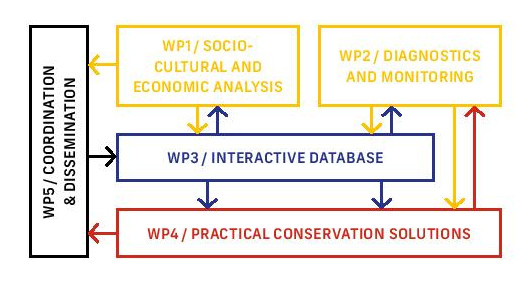CONSECH20 (“CONSErvation of 20th century concrete Cultural Heritage in urban changing environments”) was an European Project supported by the JPI CH Heritage in Changing Environments programme that ran from 2019 to mid-2022.
CONSECH20 aimed at developing innovative approaches for the conservation and protection of 20th cent. heritage concrete buildings against the ever-changing urban impacts, taking into account both technical and social aspects. The 20th cent. concrete heritage is a major challenge for conservation both because of its remarkable architectural variety and experimental character in use of materials and technologies as well as due to the lack of recognition of its cultural and historical value by the wide public. These aspects, together with the fast-changing urban environment, are leading causes of its deterioration and, sometimes, demolition.
CONSECH20 focused on constructions built with 20th cent. historic concrete (primarily until 1960) with social interest in the sense of bringing people together (e.g. for recreation, inhabiting, working) to strengthen the link between society and 20th cent. architectural heritage. The objectives were the following:
(i) Increase the potential of 20th cent. historic concrete CH as a promotion vector for social integration and cultural tourism,
(ii) Contribute to the establishment and development of the notion of Heritage Science, a relatively new and emerging field of science that aspires to bridge the gap between humanities and applied sciences,
(iii) Outline new approaches to participatory monitoring and conservation/restoration for future use of modern architectural heritage by stakeholders, and
(iv) Outline new approaches for citizen engagement in the protection of modern architectural heritage.
The objectives of CONSECH20 were achieved through a methodological approach involving the following 5 work packages (WPs):

CONSECH20 focused on urban contexts with divergent geographical, cultural, political, and economic features. Case studies in Cyprus, Czech Republic, Italy, and The Netherlands were selected. The aim was to gather a representative selection of architectural styles, materials, structural systems, conservation state, social relevance, etc. Public, municipal and state-owned buildings with social interest mostly built until 1960 were primarily considered.
The different categories of buildings defined for CONSECH20 were:
- Buildings that have undergone past conservation/re-use interventions (lessons from the past), and
- Buildings in need of conservation/restoration for future use – conservation proposals were formulated for these case studies.
The surveys performed in the selected buildings are available in the project database.
